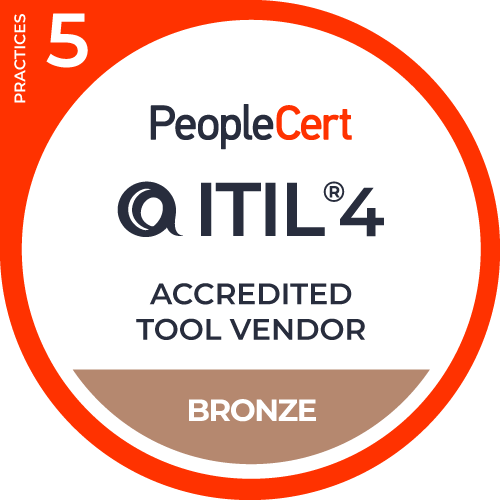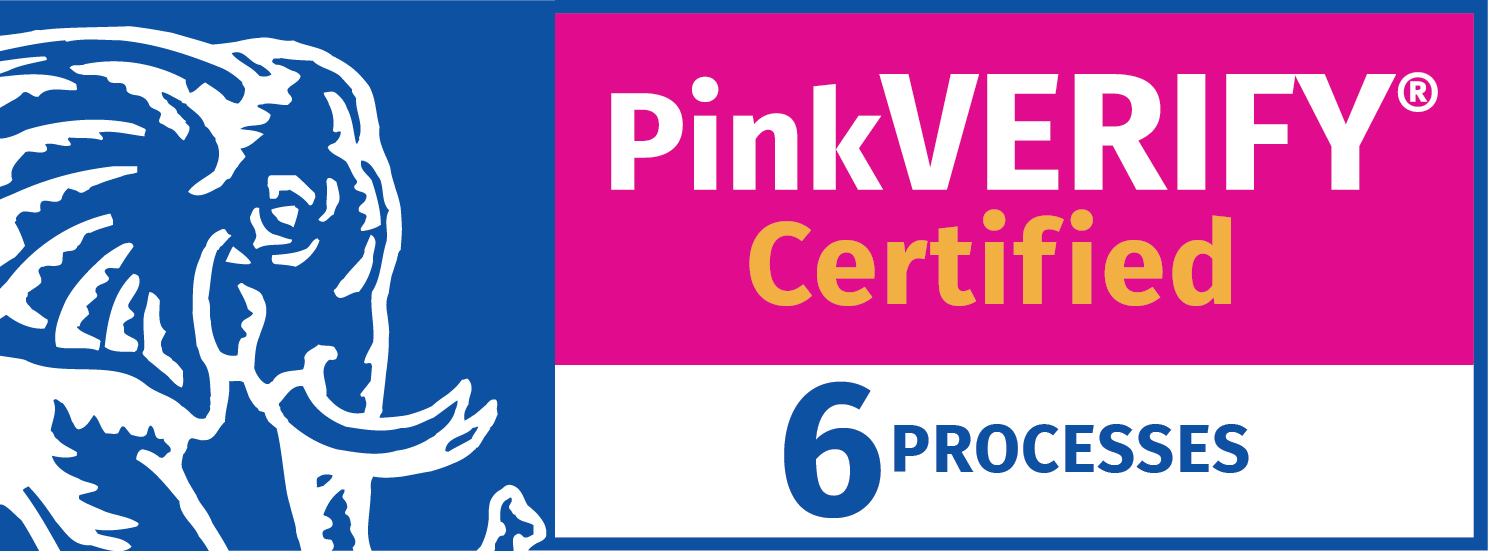The Definitive Guide to Problem Management
Learn how to implement Problem Management in your business to improve organizational efficiency.

The Definitive Guide to Problem Management
The difference between a resilient IT environment and one that is constantly struggling with recurring issues boils down to effective Problem Management.
This practice plays a crucial role in IT Service Management, and to fully comprehend what it entails, we’ll start at its core. Problem Management is more than just managing problems; it’s about understanding them deeply, preventing their recurrence, and improving overall service quality.
This guide will take you through its essentials, offering a blend of practical advice and strategic insights to help you manage a wide range of IT situations more effectively.
Whether you're new to the field or a seasoned IT professional, you'll find this guide to be an invaluable resource. We’ll cover everything from the basics to advanced practices, equipping you with the knowledge and tools needed to handle problems proactively and efficiently.
Dive in and discover how a strong grasp of Problem Management can elevate your IT service operations.
What is Problem Management?
Problem Management is a process in ITSM that focuses on identifying, analyzing, and managing the root causes of recurring incidents within an IT environment. Rather than quickly resolving immediate issues to restore normal service operation, Problem Management takes a deeper dive to prevent these incidents from happening in the first place or reduce their impact.
The goal of this root cause analysis is to improve overall system reliability and reduce the number of incidents over time.
For example, imagine a company experiencing frequent system outages caused by a specific server malfunction. Problem Management would investigate why the server keeps malfunctioning, whether it’s a hardware defect, a software bug, or a configuration issue. By addressing the underlying matter, Problem Management aims to prevent future outages, leading to a more stable IT environment.
ITIL 4 Problem Management
Before diving into the details of ITIL 4 Problem Management, it’s a good idea to fully understand the key concepts of a “problem” and a “known error”. These terms play a crucial role in how Problem Management functions within ITIL, helping organizations proactively address issues and minimize disruptions.
Let’s start by breaking down what these two concepts mean.
What is a problem in ITIL 4?
In ITIL 4, a problem is defined as the cause, or potential cause, of one or more incidents. Unlike incidents, which are disruptions to normal service operation, problems are often underlying issues within the IT infrastructure. These problems may not always be linked to a specific incident but can lead to recurring disruptions or outages if left unresolved.
Think of problems as the root cause of the IT headaches that surface as incidents. By identifying these causes early on, Problem Management works proactively to prevent incidents before they even happen, saving time and minimizing service disruptions.
What is a known error in ITIL4?
A known error, on the other hand, refers to a problem that has been analyzed but not yet fully resolved. Essentially, the issue has been identified and documented, and although a workaround or even a permanent fix may have been proposed, the solution hasn't been fully implemented yet.
Known errors are a key component of effective Problem Management because they help mitigate the impact of ongoing issues. While a permanent solution is still being developed, these documented known errors can be referenced from the Known Error Database (KEDB) to apply temporary workarounds, keeping the system running smoothly in the interim.
What is ITIL 4 Problem Management?
Problem Management in ITIL 4 is more than just resolving incidents. It’s a structured approach aimed at managing the lifecycle of all problems, with the goal of preventing incidents and minimizing the impact of those that cannot be avoided.
By addressing both problems and known errors, Problem Management ensures IT services run more smoothly, reducing the likelihood of future disruptions.
Problem Management vs. Incident Management
Problem Management and Incident Management are closely related but serve different purposes. The first concept focuses on identifying and eliminating the root causes of incidents to prevent them from happening again.
The latter looks to restore normal service operation as quickly as possible to minimize impact on the business. While Incident Management is reactive and deals with immediate issues, Problem Management is more strategic, aiming to reduce the occurrence of incidents over time.
Problem Management vs. Change Management
Problem Management and Change Management are interconnected processes in ITSM. Problem Management often asks for changes in the IT environment in order to resolve the identified underlying problems.
This is where Change Management steps in. The practice is in charge of governing how these changes are implemented in a controlled and systematic way to minimize risk and disruption to the business.
So, while Problem Management identifies what needs to be changed, Change Management ensures that these changes are carried out smoothly and with minimal impact on service continuity.
Reactive vs. proactive Problem Management
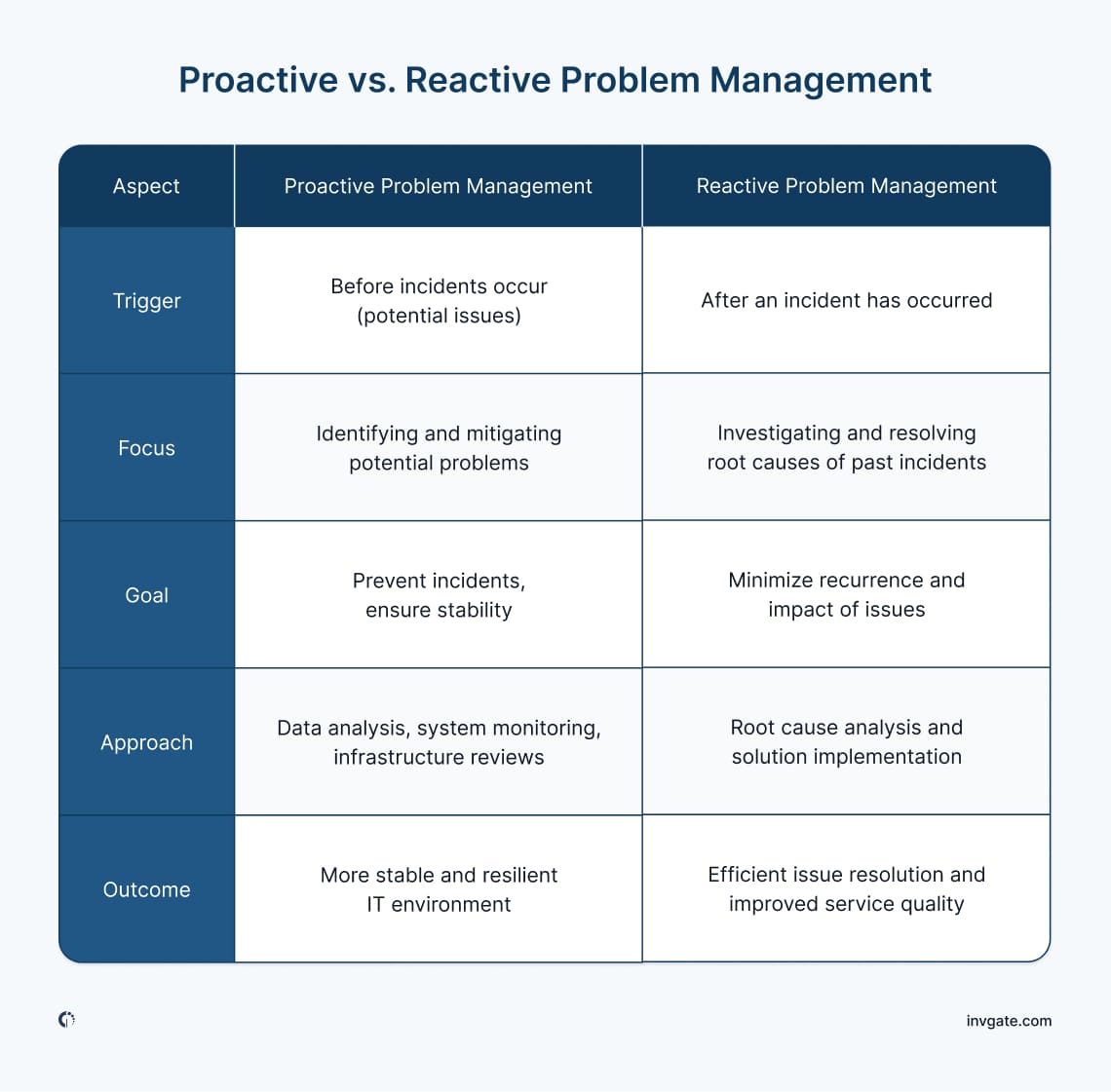
Now that we have clearly set out the scope of action, we will explore Problem Management processes in a bit more depth.
Reactive and proactive Problem Management are two complementary approaches that together form a comprehensive Problem Management strategy.
Reactive Problem Management is triggered after an incident has occurred. It focuses on investigating and resolving the root causes of incidents that have already disrupted services. The goal is to minimize the impact of recurring issues by understanding why they happened and implementing solutions to prevent them from reoccurring. This approach is essential for maintaining service quality and ensuring that issues are addressed efficiently once they surface.
On the other hand, proactive Problem Management aims to identify and mitigate potential problems before they lead to incidents. This approach involves analyzing data trends, monitoring systems for warning signs, and conducting regular reviews of the IT infrastructure to detect vulnerabilities or areas of improvement. By performing proactive support, organizations can prevent incidents from happening in the first place, leading to a more stable and resilient IT environment.
When combined, both approaches create a robust Problem Management practice. While reactive ensures that current issues are resolved and do not persist, proactive helps in reducing the overall number of incidents by anticipating and addressing potential problems. Together, they form a balanced approach that enhances service reliability, minimizes disruptions, and continuously improves IT operations.
Problem Management vs. Knowledge Management
Problem Management and Knowledge Management both play critical roles in ITSM, but they address different aspects of managing IT services.
Problem Management focuses on identifying and resolving underlying issues that cause incidents, whereas Knowledge Management is concerned with capturing, sharing, and effectively using information and knowledge within an organization.
Knowledge Management supports Problem Management by providing insights, solutions, and documentation that can help in identifying and resolving problems more efficiently.
5 benefits of Problem Management
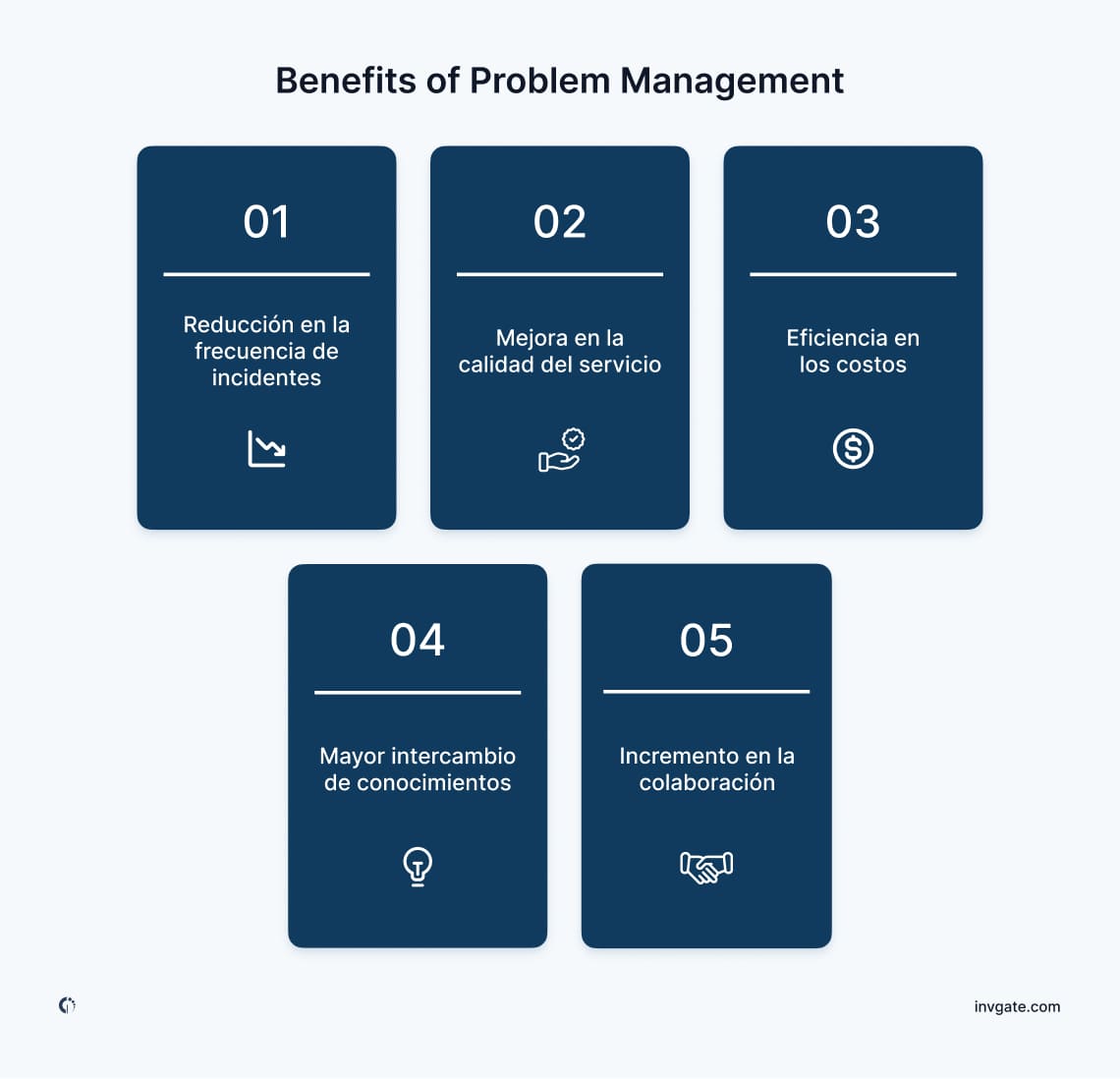
Problem Management is a cornerstone of effective IT Service Management, offering organizations the tools and strategies needed to tackle recurring issues at their roots. By focusing on identifying and resolving the underlying causes of incidents, it not only improves the stability and reliability of IT services but also drives long-term efficiencies and cost savings.
Here are five key benefits that illustrate why Problem Management is essential for any organization aiming to enhance its IT operations and service delivery.
- Reduced incident frequency: By identifying and addressing the root causes of recurring incidents, Problem Management significantly reduces the number of incidents that occur. This leads to fewer service disruptions and a more stable IT environment, allowing businesses to operate more smoothly.
- Improved service quality: Problem Management enhances the overall quality of IT services by preventing issues from reoccurring. With fewer disruptions, users experience better service continuity, which leads to increased satisfaction and trust in the IT department.
- Cost efficiency: By proactively addressing issues before they escalate into major incidents, Problem Management helps organizations avoid costly downtime and resource-intensive fixes. This results in more efficient use of IT resources and a reduction in the financial impact of service interruptions.
- Enhanced knowledge sharing: Problem Management encourages the documentation and sharing of solutions to recurring problems. This knowledge is valuable for preventing similar issues in the future and can be leveraged across teams to improve overall IT practices and decision-making.
- Increased collaboration across IT teams: The process of identifying, analyzing, and resolving problems often involves multiple IT teams working together. Problem Management fosters better communication and collaboration across these teams, leading to more effective problem resolution and a stronger, more unified IT organization.
Problem Management process
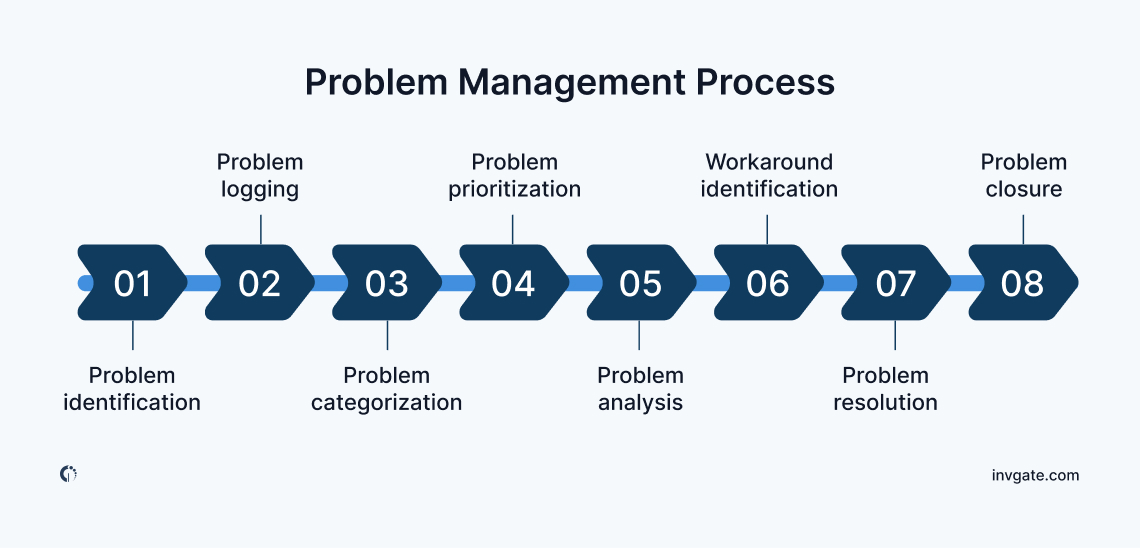
A Problem Management process is a structured approach to identifying, analyzing, and resolving problems within an IT environment. Implementing these steps effectively requires a well-organized strategy, and leveraging ITSM tools to streamline this process, ensuring consistency and efficiency.
Below is a brief overview of the eight-step process:
- Problem identification: This initial step involves detecting and logging problems, whether through incident analysis, proactive monitoring, or user reports.
- Problem logging: Once identified, the problem is documented in a problem record, capturing all relevant details to track and manage its resolution.
- Problem categorization: Problems are categorized to prioritize and assign them appropriately, helping teams focus on the most critical issues first.
- Problem prioritization: Problems are ranked based on their impact and urgency, ensuring that high-priority issues are addressed promptly to minimize business disruption. You can use an ITIL priority matrix to do so.
- Problem analysis: The root cause of the problem is investigated using techniques like root cause analysis to understand why the problem occurred and how it can be resolved.
- Workaround identification: Temporary solutions, or workarounds, are identified to minimize the impact of the problem while a permanent fix is developed.
- Problem resolution: A permanent solution is implemented to eliminate the problem, ensuring it does not recur.
- Problem closure: The problem record is updated and closed once the solution has been verified, and any lessons learned are documented for future reference.
Successfully managing these steps often requires the support of software that is up to the challenge, which we'll explore further in the next section.
Problem Management tools
Problem Management is one of the essential practices that can be carried out using an ITSM tool, which is why it's important to choose a verified solution that supports this functionality. The right tool helps IT teams track problems, analyze root causes, and implement long-term solutions seamlessly.
With Problem Management software, you can manage problem records, conduct root cause analysis, and implement solutions with greater ease. These tools provide a centralized platform for tracking and managing problems, improving communication and decision-making within IT teams.
By ensuring your chosen ITSM tool is verified for Problem Management, you guarantee that your organization can operate more effectively in addressing recurring incidents and preventing future disruptions.
Here's a closer look at the types of tools that can support the Problem Management process:
- Problem logging and tracking: ITSM tools allow organizations to log, categorize, and prioritize problems in a systematic way. This ensures that nothing falls through the cracks and that all issues are addressed based on their urgency and impact.
- Root Cause Analysis (RCA): Advanced ITSM tools offer built-in capabilities for conducting root cause analysis, helping teams identify the underlying causes of incidents more efficiently.
- Workflow automation: Automating workflows within the Problem Management process can significantly reduce manual effort and ensure that problems move through the resolution process smoothly.
- Collaboration features: ITSM tools often include features that facilitate collaboration among IT teams, enabling them to work together effectively to resolve problems.
- Reporting and analytics: Comprehensive reports and dashboards help organizations track the performance of their Problem Management process, identify trends, and make data-driven decisions to improve future outcomes.
InvGate Service Management as your Problem Management software
Of course, you can use InvGate Service Management to help you out with the Problem Management processes – in fact, it is certified by PeopleCert and Pink VERIFIED on this (and other) practices.
Here’s how InvGate Service Management supports your Problem Management efforts:
- Workflow module: InvGate Service Management’s no-code workflow builder allows you to automate and streamline the Problem Management process. You can define and customize workflows to ensure that problems are logged, categorized, and resolved according to your organization's specific needs. Automation helps reduce manual intervention, ensuring that problems progress through each stage smoothly and efficiently.
- Reports and dashboards: The tool comes with comprehensive reporting and dashboard features that offer valuable insights into your Problem Management activities. You can generate detailed reports on problem trends, resolution times, and other Problem Management key metrics, enabling you to track performance and identify areas for improvement. The intuitive ITSM dashboards give you a real-time view of your Problem Management landscape, helping you make informed decisions and prioritize tasks effectively.
Problem Management roles and responsibilities
Apart from robust processes and the right tools, effective Problem Management requires a well-defined team structure with clearly defined roles and responsibilities. Each role within the Problem Management team plays a crucial part in ensuring that problems are identified, analyzed, and resolved efficiently.
Here's an overview of the key roles involved and their respective responsibilities:
| Role | Responsibilities |
|---|---|
| Problem Manager | Oversees the entire Problem Management process, ensuring that problems are managed effectively from identification to resolution. Coordinates with other IT teams and stakeholders. |
| Problem Analyst | Conducts detailed analysis to identify the root causes of problems. Works on developing and implementing solutions, and ensures that known errors are documented and managed. |
| Incident Manager | Manages incidents that may lead to problems. Works closely with the Problem Manager to ensure that the resolution of incidents does not become a recurring problem. |
| Change Manager | Coordinates with the Problem Management team to assess and implement changes needed to resolve problems. Ensures that changes are controlled and minimize service disruption. |
| Knowledge Manager | Maintains and updates the knowledge base with information related to problems and their resolutions. Ensures that knowledge is available to help prevent future problems. |
Finally, the Service Desk plays an essential role in ensuring that problems are identified, escalated, and mitigated effectively. Although the Service Desk doesn’t precisely find or solve your problems, it plays a supportive role that ensures the Problem Management process flows smoothly.
While directly managing or solving problems is typically the responsibility of the Problem Manager or technical teams, it acts as a crucial bridge between end-users and the Problem Management team.
Problem Management key terms
Understanding the key terms related to Problem Management is essential for grasping the full scope of the process and its role in IT Service Management. Here’s a glossary of the most important terminology to help you get familiar with Problem Management concepts:
- Problem: The underlying cause of one or more incidents. Problems are identified to prevent future incidents and improve IT service quality.
- Incident: An unplanned interruption or reduction in the quality of an IT service. Incidents are addressed through Incident Management, while Problem Management focuses on the underlying causes.
- Known Error: A problem that has been analyzed and for which a root cause has been identified, but a permanent solution has not yet been implemented. Known errors often have a temporary workaround in place.
- Root cause analysis: A technique used to identify the fundamental cause of a problem. RCA helps in understanding why a problem occurred and is crucial for finding effective solutions.
- Workaround: A temporary solution implemented to minimize the impact of a problem while a permanent fix is being developed. Workarounds help in maintaining service continuity until a more permanent solution can be applied.
- Problem Record: A document or entry in a Problem Management system that tracks details about a problem, including its status, impact, and resolution. It serves as a reference throughout the problem’s lifecycle.
- Problem Management Process: The systematic approach used to manage problems, including identification, logging, categorization, prioritization, analysis, resolution, and closure.
- Proactive Problem Management: The approach of identifying and addressing potential problems before they cause incidents. This involves analyzing trends and monitoring systems to prevent issues from arising.
- Reactive Problem Management: The approach of addressing problems after they have caused incidents. This involves investigating the root causes of issues that have already disrupted services.
- Known Error Database (KEDB): A repository where information about known errors and their workarounds are stored. The KEDB helps in quickly resolving issues and preventing recurrence by providing accessible knowledge.
In conclusion
In this article, we've navigated the key aspects of Problem Management, unraveling how it fits into the broader IT Service Management landscape. We explored the distinction between reactive and proactive approaches, highlighting how addressing issues before they escalate can significantly enhance IT service stability. We also delved into the essential roles within a Problem Management team, each contributing to the smooth resolution of problems and the prevention of future incidents.
Finally, let's highlight the importance of using a robust Problem Management tool, such as InvGate Service Management. If you're ready to experience it firsthand, don't forget you can always sign up for our 30 day free trial or arrange a call with our team, who will guide you through the tool and any questions that you might have.
Frequently Asked Questions
Check out InvGate as your ITSM and ITAM solution
30-day free trial - No credit card needed
